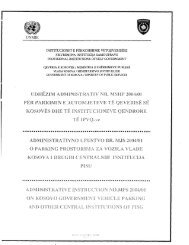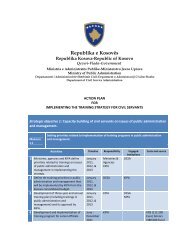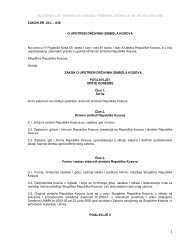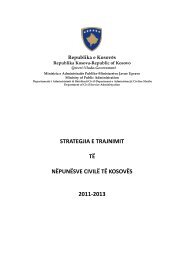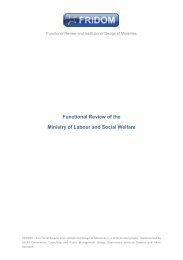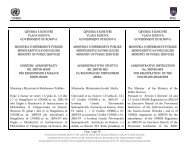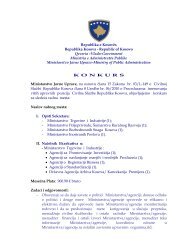Download
Download
Download
You also want an ePaper? Increase the reach of your titles
YUMPU automatically turns print PDFs into web optimized ePapers that Google loves.
The roles and functions of the boards could be considered as part of the Institutional Development<br />
Plan and the issue with the payment of these entities addressed.<br />
SECTION XII: Examples from other countries<br />
Care needs to be taken in using other countries’ examples of arrangements for their MOH as a guide<br />
as the structure and functions of ministries reflect the unique constitution, government arrangements,<br />
culture and history of each country. While there is much to be learned from other countries, the<br />
Kosovo Government needs to interpret examples in the context of what will work well in this country.<br />
Many OECD countries have advanced purchaser/provider splits and many health providers,<br />
sometimes including health insurance arrangements. Some recent EU entrants are still carrying the<br />
legacies of the Soviet health structures that are not functioning well and should not be replicated in<br />
Kosovo. With these reservations in mind about considering country examples in context, some<br />
general observations are set out in this section. Compared to some OECD countries, the unusual<br />
features of the structure of the Kosovo MOH include:<br />
The large number of reporting positions to the PS<br />
The large number of corporate services and the low number of health policy, planning and<br />
monitoring services in the upper levels of the MOH structure<br />
The role of the MOH as a service provider with staff and other costs of many health service<br />
providers under its direct control, including appearing in the MOH’s budget detailed to the<br />
level of economic classifications<br />
The fragmented nature of some of the MOH’s functions with many offices, divisions, centres,<br />
and inspectorates and many specialised positions with few generic policy, planning and<br />
monitoring positions<br />
The large number of doctors holding management positions and the lack of other skills and<br />
background in management positions<br />
Compared to some recent entrants to the EU and countries in this region, the Kosovo MOH is<br />
unusual in some of the areas mentioned above. For example:<br />
They commonly have far fewer direct reports to the equivalent PS position when there is<br />
one.<br />
They commonly have more than one health service as a direct report to the PS, for example<br />
Lithuania has a public health division and a personal health division with high level reporting<br />
positions; Slovenia has a directorate for public health and a directorate for health protection<br />
reporting at a high level; Latvia has public health, heath care and pharmacy reporting at a<br />
high level. The Albanian MOH has concentrated its corporate services and has more health<br />
service areas at the upper levels of the structure (primary health; hospitals;<br />
pharmaceuticals).<br />
Many countries have created semi-autonomous formal structure for the hospitals as<br />
described below. Kosovo has made steps in this direction, but has not established some of<br />
the essential elements to support a semi-autonomous structure as discussed earlier. 8<br />
The table below sets out the organisation of hospitals in some recent EU entrant countries.<br />
8 World Bank, “Kosovo Health Financing Reform Study,” 2008, op cit., page 5.<br />
35



